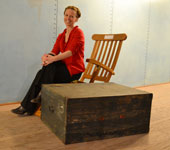The trauma of a long quarantine stripped a young Michael Frederiksen of his languages.
Michael left Denmark with his family and arrived in Canada in late June of 1951 while the epidemic was raging. Not long after, he contracted it.
“The summer of ’51 was devastating,” Michael wrote. “Canada had not experienced what it was like to live through a full-blown polio epidemic. There were no vaccines to combat this deadly virus.
“80,000 Canadians became ill, one quarter died of respiratory failure. Three months after leaving Denmark I became a statistic. The next nine months were spent in quarantine at Toronto’s Sick Kid’s Hospital.
“The experience was so traumatic that I lost facility for both mother tongues, Danish and Russian. Much of my childhood memories became blurred or lost during that time.”
Michael made a full recovery and writes that he quickly learned to speak English and gradually found his Danish coming back. As soon as he was well enough to travel he and his mor (mother) joined his far (father) who had already found a job in Vancouver.
The family loved Vancouver.
“Denmark is surrounded by water and is made up of over 500 islands,” Michael wrote. “I believe that is why Mor and Far loved the west coast of Canada so much; it reminded them of their roots.”
That is a good reminder for all of us to get outside when we can and where we can to enjoy the natural beauty of spring in Canada. Thanks Michael.
